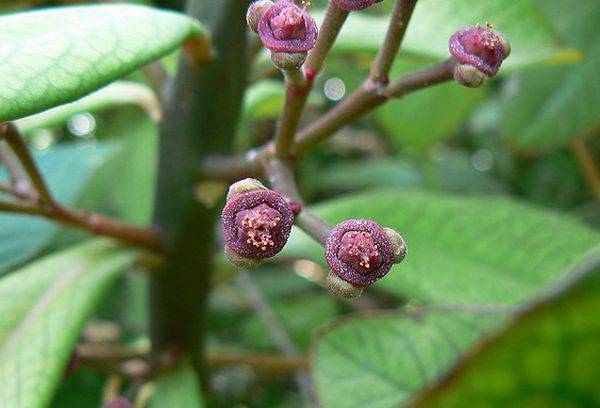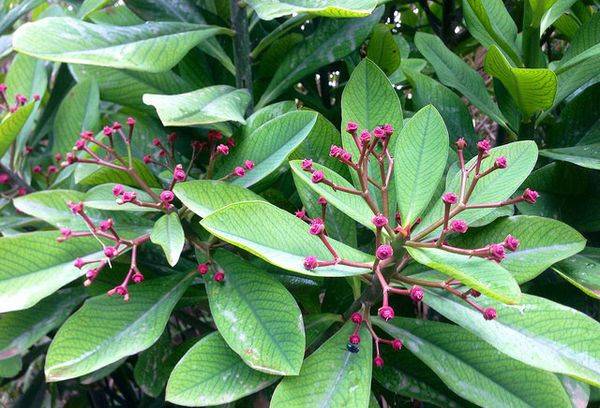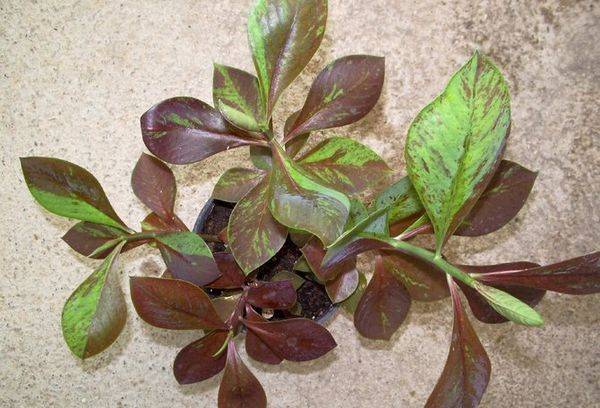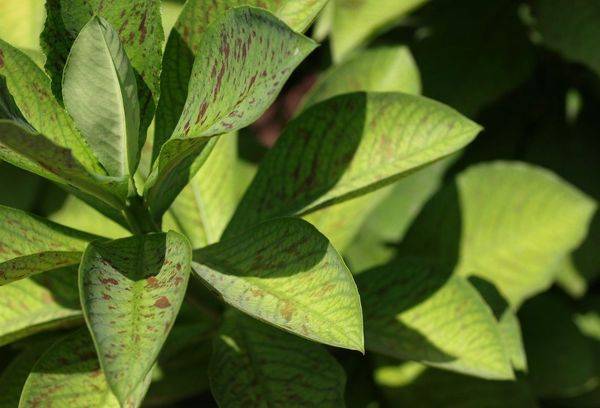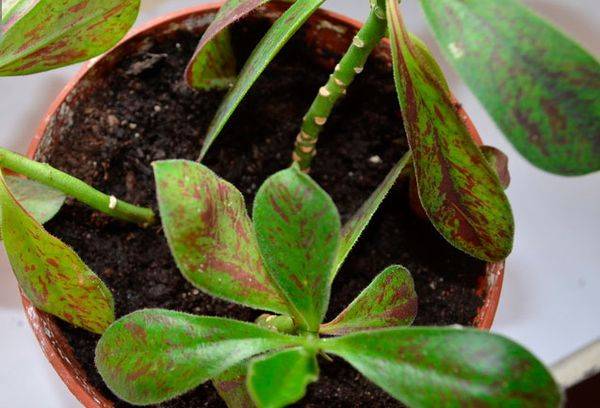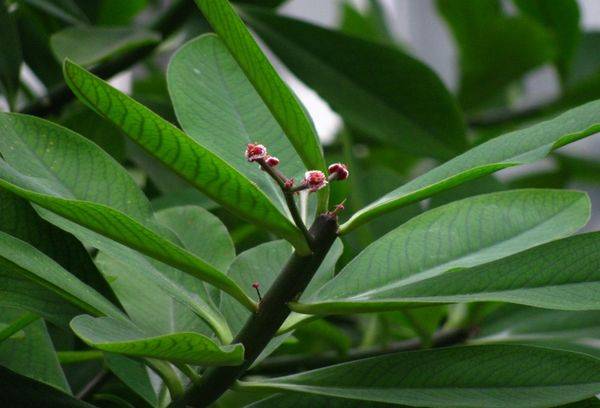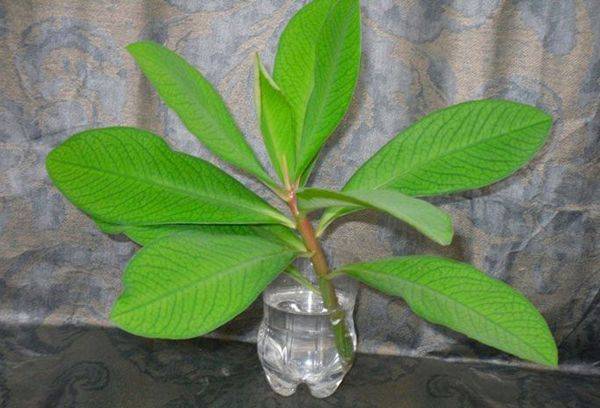The tree of love: how to care and what you need to know about the African Sanadenium
Content:
Sinadenium is a tall and beautiful evergreen shrub with powerful stems and numerous tender leaves. The plant is unpretentious and viable, therefore, care for it at home is both a beginner grower and a person with experience cultivating indoor plants. An important nuance - synadenium refers to poisonous crops, so you should be careful in communicating with it and if there are pets.
Grant Sinadenium - description and features
The genus synadenium is small in number, has only 20 species, among which there are wild and decorative representatives. The cultivated species of Synadenium grantii belongs to the family of euphorbiaceae. In places of damage, white milky juice is released. The flower reaches large sizes and has an African origin. In indoor conditions, flowering is extremely rare.
There are 2 most common decorative foliage forms:
- Grant's synadenium. This plant with massive stems and oval long green leaves sitting on short petioles. It has a high growth rate, over a year it can grow in length by 20-25 cm. Adult plants stretch to 1.5-2 meters in height. In the tropics, there are four-meter representatives. Young shoots are first green, then a tree bark forms on their surface. Flowering - small red flowers collected in tassels, at the very top of the stems.
- Sinadenium Rubra. This variety has large oval leaves painted dark red. Sometimes foliage is covered with reddish stains in the form of a picture. Large shrub with succulent fleshy stems. Houses prefers well-lit window sills on the southeast side. The leaf is dense and shiny, it contains the necessary moisture supply for the flower. Milky juice is poisonous, often causing irritation and soreness of the skin.
Tip
purityis.decorexpro.com/en/ magazine draws your attention: regular pruning will form a small volume shrub from the synadenium according to the size of the windowsill. Growing freely, Synadenium turns into a tall tree with a powerful spreading crown.
Care Rules
The synadenium is an euphorbia, therefore it is characterized by an upright fleshy stalk and succulent side branches. Its leaflets are long and tender in structure. A large amount of milky juice is immediately released on the cut. Stop it with warm water.
Conditions for a comfortable existence:
- Lighting. The diffused sunlight is useful to the synadenium, direct rays can burn the leaves and stem of the plant. The lack of lighting makes the plant lethargic and weak, it loses its visual appeal. In the winter season can not do without an artificial light source.
- Temperature. The optimal temperature range for good growth and development of the flower is in the range from +20 to + 26 ° C. Sharp fluctuations are undesirable for him.
- Humidity. Moderate humidity of air and soil is what a flower needs in a home environment. In summer, the plant should be watered more often and more abundantly; by winter, moisture is reduced.
Tip
Sinadenium loves cleanliness, so pamper it more often with rinsing leaves and stems. Water procedures will protect the plant from diseases and create a favorable microclimate around it.
Home care:
The soil. An ideal base for growing synadenium is a light and nutritious soil with neutral acidity.To cook it, take in equal parts humus, turf and peat soil, brick chips and coarse river sand. Blotches of crushed charcoal will be useful for the flower. A generous layer of expanded clay is suitable as drainage.
Watering. Flower synadenium belongs to the category of drought tolerant plants. Therefore, it should be watered as necessary: when the top layer of soil in the pot dries by 1-2 cm. Stagnant water at the base of the stem and in the roots leads to decay and damage to the flower.
Top dressing. According to the rules, top dressing in the form of mineral and organic fertilizers should be applied in the spring. During the year, the indoor flower should be fed no more than once a week. Excess fertilizer in the ground leads to its drying out.
Pruning. Forming bush pruning is carried out at the request of the owner and as the branches grow. Sanitary pruning stimulates the renewal of the bush and should be carried out regularly and in a timely manner.
In synadenium, the main thickened stalk is expressed, lateral processes are rare. If you stick the main trunk, it stimulates the occurrence of side shoots. Thus, the flower will become more spreading and beautiful. In the green mass, the plant accumulates moisture, which is vital for it in tropical conditions of existence. It is perfectly adapted to a living environment - it survives the heat and drought in the tropics without problems.
Reproduction, transplantation, treatment
Grant's synadenium is characterized by resistance to external living conditions, is characterized by high decorative qualities, unpretentiousness and growth rate. Plant transplantation is carried out every 2-3 years, usually in the spring.
For flower propagation, stem cuttings are used, which are placed in water to grow roots, and then planted in suitable soil. For better rooting, the stalk is kept for some time in greenhouse conditions - under a transparent cap.
Important
All work with the flower should be carried out with gloves, since its milky juice is poisonous. Getting on the mucous membranes, it leads to their irritation and inflammation. If swallowed, it causes poisoning. If animals and milkweeds live on the same territory, you should be more careful.
Milk juice naturally protects the plant from pests, as it is toxic. When growing synadenium, flower growers more often do not encounter parasites, but with yellowing and wilting of foliage. The reason for this is too cold and dry indoor climate. Excess moisture leads to darkening and twisting of the leaf plate, which means the loss of decorative qualities of the flower. Leaves fall if the living conditions and the nature of the lighting have changed.
The rarely sickly and outwardly beautiful flower of the synadenium is called the "tree of love." He gratefully responds to the care and attention of the person. They can decorate the windowsill in the apartment and in the country, in the house and in the office. The only difficulty in growing this plant is to create favorable conditions around it - permissible humidity and optimal illumination.
